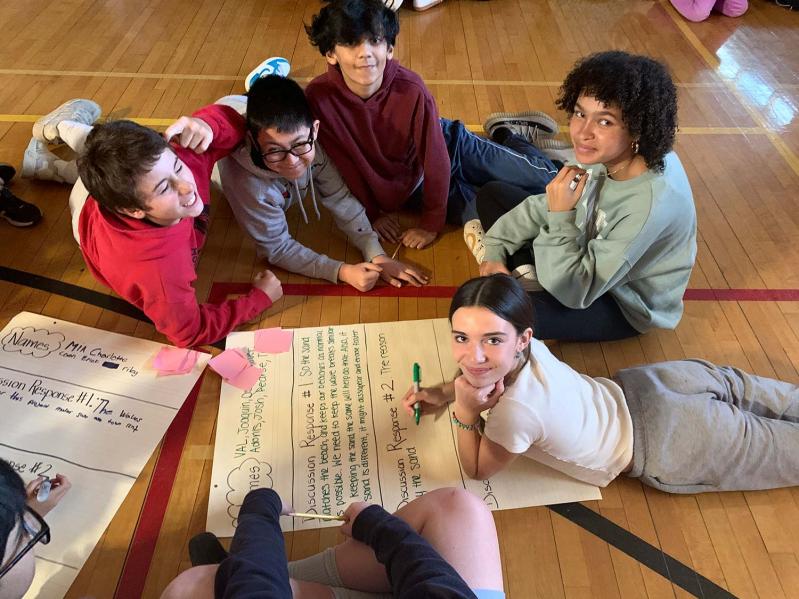As the downtown Montauk portion of the long-awaited Fire Island to Montauk Point beach reformulation project nears conclusion, students in the hamlet are both learning about the science behind the project and, through the medium of video, advocating for protection of their home.
Early in the school year, Concerned Citizens of Montauk created a STEAM (Science, Technology, Engineering, Arts, and Math) program called the Young Filmmakers of Montauk. “Through this program, C.C.O.M. shows and explains to the kids the different types of environmental projects we are working on,” Kay Tyler, C.C.O.M.’s executive director, said in an email last week, “and they tell it through their words on video.”
The Young Filmmakers, who use tools including Apple’s GarageBand music and podcasting software, started work on a video about the Fire Island to Montauk Point project, or FIMP, in October. After three storms in December and January caused severe erosion and damage to the ocean beach and dune at Ditch Plain as well as downtown, Ms. Tyler said that “the kids wanted to know if they could do something to save Ditch,” which is not part of the FIMP project. They created a short video “to voice their concerns to whoever would hear,” she said.
The video is on YouTube, at bit.ly/49Zgksi. “Together, we use technology, science, and the arts to tell stories that affect our lives, now and in the future,” begins a voiceover, as still pictures and video illustrate the short film. “Ditch Plains is an important part of our community,” one student says. “We must understand the science,” says another, “so we can use it for finding solutions.” “We are talking about our future,” a group of students emphatically state in unison. “Please help save it!”
Jody Kennedy, a retired teacher in White Plains and a longtime, part-time resident of Montauk, partnered with Ms. Tyler to lead the Young Filmmakers. “We wanted to keep it small to start,” she said. “They’re in fifth through seventh grade, and very curious. We walked along that beach several weeks ago.” The group sometimes meets at C.C.O.M.’s office on South Elmwood Avenue, “which is very close to this beach,” Ms. Kennedy said.
Coen Sheffer of the Young Filmmakers created the group’s logo, Ravi Ortiz composed and recorded the video’s accompanying music, and the students are hands-on in the editing and production of their work. They are learning to start a project by gathering all assets and interviewing their primary sources, Ms. Kennedy said. “It’s all research-based, and then let your technology be the tool for you,” she said.
After the Ditch Plain video was completed, the students turned their attention back to FIMP. C.C.O.M. contacted James D’Ambrosio, a public affairs specialist with the federal Army Corps of Engineers, which planned and oversaw the FIMP project, who “was so impressed by this that he offered do a presentation at the school” for fifth through eighth graders, Ms. Tyler said.
During an interactive assembly on Friday, Mr. D’Ambrosio gave a slide presentation and quizzed some 100 students, who were divided into groups, about the science and engineering elements of beach reformulation. Keeping ocean water from inundating the hamlet’s downtown and its infrastructure is the priority, he told the students. With more than 450,000 cubic yards of sand deposited, “you’ve got a wider beach, and there’s much less chance that you’re going to have flooding in downtown,” he said.
“We want to try to give them the story behind the story and some of the science,” Mr. D’Ambrosio told The Star, “so they can put two and two together and realize that there’s a little more that goes into it than just a dredge pulling up and putting down sand for two weeks and then leaving.”
“We both believe in early childhood education,” East Hampton Town Councilman David Lys, the town board’s liaison to the FIMP project, said of himself and Mr. D’Ambrosio. “When you have a project that you can visually see as a child, but then also to explain and articulate all the background information that goes into it, you might elicit a response in that child to take a career pathway in engineering, or coastal morphology, or geology,” he said. “That’s what’s important here: We might be inspiring kids who will do something better in the world and be our next leadership.”
The town board announced last week a developing plan to rebuild the dune and renourish the beach at Ditch Plain. On Friday, Mr. Lys thanked members of the Young Filmmakers of Montauk for their efforts. “You’ve highlighted it, you brought it directly to the town government through your videos, through your P.R. campaigns, and it’s impressive to see what you, at your ages, as a group, collectively have done,” he said. “As you might have heard this week, the town board is taking action, and part of that taking of action was motivated by you and your group. So thank you very much.”
“I learned a lot about how erosion in the past has affected our beaches a lot,” Ravi told The Star, “and how it’s recently also been seeing further damage from storms and high winds.”
Avery Boerum said that she learned about GarageBand and how it can be used to edit audio. She also gave voice to the primary message of life in a tourism-dependent coastal community. “Our beaches,” she said, “are very important to where we live.”

